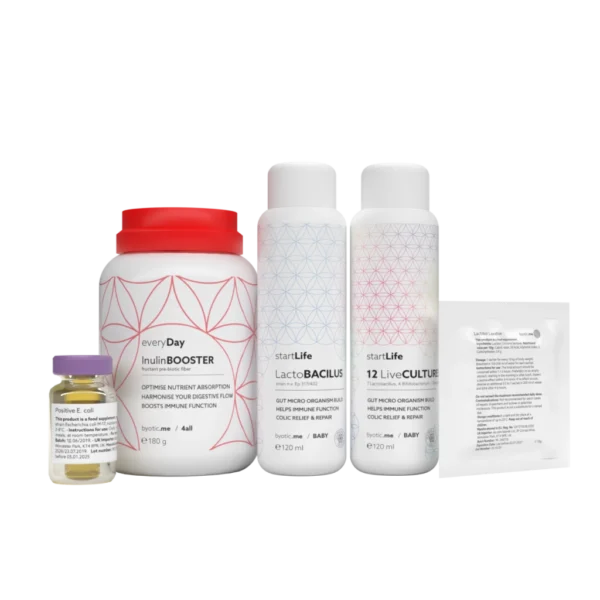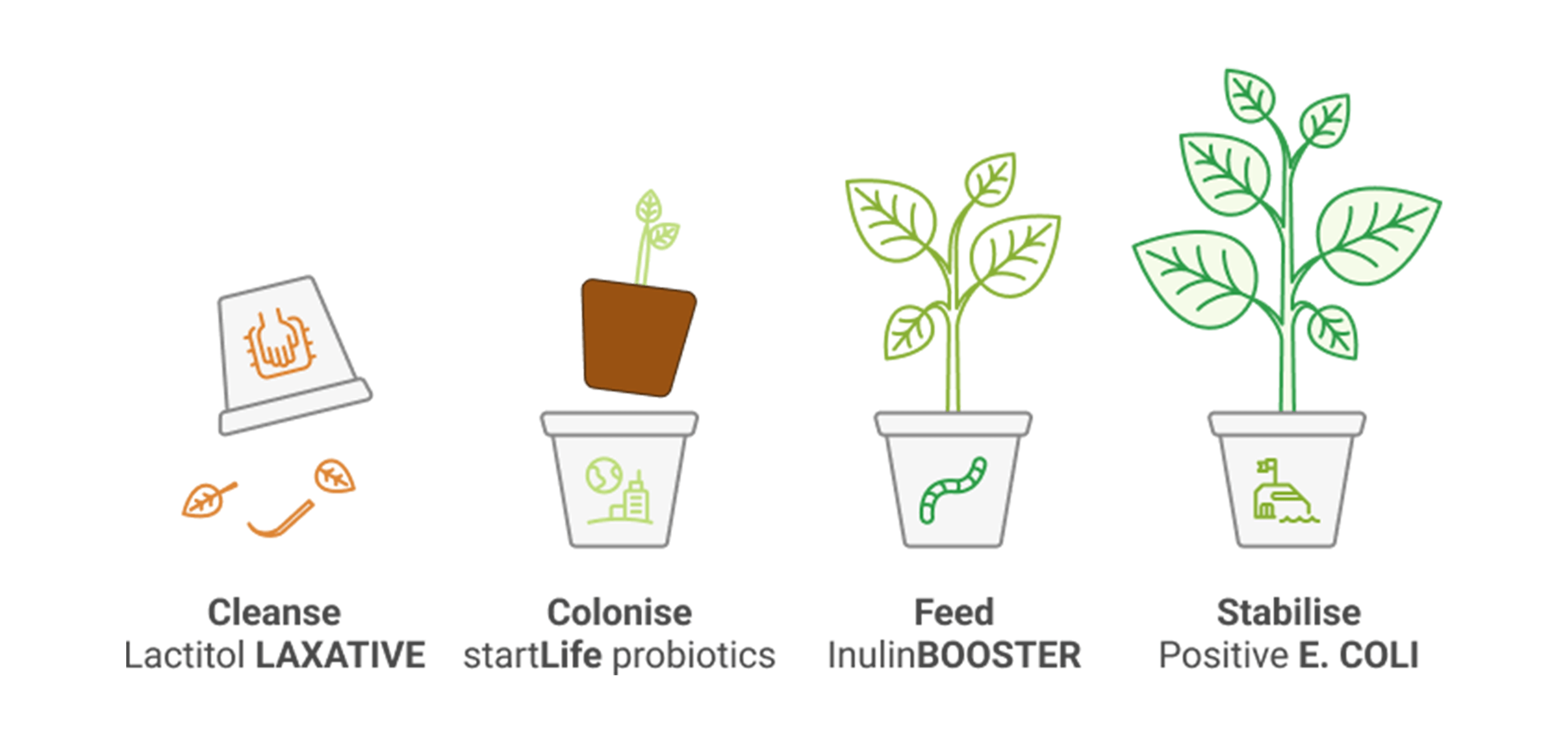Your Cart Is Empty
✖No products in the cart.
Gut Health and Immunity Boost for ages 1-3

Gut Health and Immunity Boost for ages 1-3
£ 199.00 Original price was: £ 199.00.£ 129.00Current price is: £ 129.00.
Out of stock
After seeing incredible results with the probiotic treatment I used for my baby, I couldn’t help but share my success with my sister, who had been struggling with a similar issue in her two children. Her kids, aged 2.5 and 4.5 at the time, had been suffering from severe atopic dermatitis (AD) for years.
If you’re familiar with the condition, you know it can be unbearable—large red patches on the creases of their arms and legs that itched so badly they couldn’t sleep properly. The younger one would scratch until she bled.
We had tried everything: visits to top dermatologists in Munich, homoeopathy, and various topical treatments. While cortisone creams provided short-term relief, they created a vicious cycle, requiring stronger and more frequent applications. Worse, the condition kept coming back with the same intensity, leaving us feeling desperate.
Given my positive experience with StartLife probiotics, I extensively researched the gut-skin connection and how gut flora (dysbiosis) imbalances can exacerbate skin conditions like AD. I suspected that the gut flora in my sister’s children was severely out of balance, as they exhibited other telltale symptoms of dysbiosis, including recurring infections and colds, constant runny nose during the winter months and some food intolerances.
I proposed a course of treatment using probiotics designed for toddlers aged 1-3, tailored to their needs. Understandably, my sister was sceptical after the countless treatments they had already tried. But we were both amazed when, by the end of the first course, we noticed a significant reduction in the severity of their symptoms. The itching subsided, and the red patches began to fade.
For the older child, whose condition was more severe, it was recommended to follow up with two consecutive courses of probiotics and supplement the treatment with Inulin for an additional three months to restore the balance in their gut fully. It was a slow but steady process, and after completing the treatment, both children’s atopic dermatitis disappeared entirely—and to our great surprise, it has never returned. Their immune systems are now stronger, and overall, they are healthier than ever.
Since then, probiotics have become a staple in our family’s health routine. We now use them after illnesses, during periods of high stress, poor diet, or simply as a preventive measure at least once a year, ensuring that we maintain a healthy gut flora balance.
The transformation I saw in my sister’s children reaffirmed the incredible potential of StartLife probiotic treatments. I’m so grateful we found this solution—it changed their lives.

Marina B.





Lactitol is a laxative used for gastrointestinal cleansing prior to probiotic supplementation, ensuring thorough cleansing and enhancing bacterial colonisation in the gut. It works by interacting with water in the intestines to soften stool, facilitating effective bowel evacuation through negative osmotic pressure. This process allows probiotics to settle and colonise more effectively in the gut. Compared to other laxatives such as lactulose, lactitol has fewer side effects, such as bloating and gas. It also offers prebiotic benefits, supports beneficial gut bacteria, and is suitable for diabetics as it does not raise blood sugar levels.
Lactobacillus & 12 live Cultures help restore gut health by reintroducing beneficial bacteria like Lactobacillus and Bifidobacteria. showing significant improvements in gut health. They offer a one-time solution that addresses gut health at its root, delivering lasting results without the need for continuous use. These probiotics help to balance the microbiome, improve digestion, and strengthen immunity, which is crucial after antibiotic use or gut imbalances.
Inulin Booster is a natural prebiotic fibre derived from chicory. It supports gut health by feeding beneficial bacteria (Bifidobacteria and Lactobacilli), improving digestion, and enhancing immunity. Low-calorie and suitable for diabetics, it supports healthy digestion, helps regulate bowel movements, and promotes overall gut health. Inulin passes undigested to the colon, where it ferments, boosting the growth of good bacteria. It also enhances the immune system and overall well-being by binding to unwanted substances like heavy metals, cholesterol crystals, and toxins, promoting their elimination.
Positive E. coli is a probiotic supplement containing the non-pathogenic strain Escherichia coli M17, known for its health benefits. It helps synthesise vitamin K, strengthens the intestinal lining, boosts natural defences, and prevents harmful bacteria from colonising the gut. Specially formulated to restore beneficial bacteria in the colon, it supports digestion and overall gut health, particularly in cases of chronic constipation or diarrhoea. Each bottle delivers over 10⁶ CFU/ml of live E. coli M17 in a nutrient-rich medium.
In your package you will receive all the necessary items to ensure proper management of the live probiotics and the accessories needed to administer in a simple and fun way for your baby. Administering is really made easy with our special string mimicking the mother’s nipple which is given during or before the breastfeeding.

These products are food supplements and do not contain allergens. They are completely natural products and do not contain synthetic essences, stabilizers, colorants, or preservatives.
startLife Probiotics
Ingredients
“LactoBACILUS” (120ml):
Live acidophilic bacteria Lactobacillus acidophilus strain n.v. Ep 317/402 ≥ 10⁹ CFU/ml at the time of production, their metabolites, and a nutrient medium.
startLife “12 LiveCULTURES” (120ml):
12 types of live probiotic bacteria: Lactobacillus rhamnosus, Bifidobacterium bifidum, Lactobacillus acidophilus, Lactobacillus casei, Lactobacillus plantarum, Lactobacillus salivarius, Bifidobacterium longum, Streptococcus thermophilus, Lactobacillus bulgaricus, Lactobacillus paracasei, Bifidobacterium lactis, Bifidobacterium breve ≥ 10⁹ CFU/ml at the time of production, their metabolites, and a nutrient medium.
Contraindications and Side Effects
Do not use startLife “LactoBACILUS” and “startLife 12 LiveCULTURES” if your baby is intolerant to any probiotic ingredients.
Storage
Use until the quantity in the bottle is empty, but at most 14 days after opening.
Lactitol Laxative
Ingredients
100% Lactitol. Contains lactose.
Side Effects
Do not take in cases of hepatic encephalopathy or lactose intolerance.
Storage
Keep in a cool, dry place below 25°C, away from children.
Inulin Booster
Ingredients
100% water-soluble plant powder from chicory.
Side Effects
No known contraindications have been observed.
Storage
Due to its hydroscopic nature store in a cool (20-22°C/68-71°F) and dry (<38% humidity) place, away from moisture and direct sunlight.
Positive E. Coli
Ingredients
Live active bacteria Escherichia coli of the non-pathogenic strain M17 in a nutrient medium, in a quantity of ≥10⁹ CFU/ml at the time of production.
Side Effects
Hypersensitivity to the ingredients. In cases of specific and nonspecific ulcerative colitis. Do not use the product if you are allergic or hypersensitive to E. coli strain M17 or to any of the product’s ingredients.
Storage
Packaging
Box size – 23x21x11cm
2 x 120ml bottles
1 x 180gr bottle
3 x 15gr sachets
1 x 10ml bottle
3 x single-dosage syringes
1 x syringe, brush and box
1 x tempered travel bag
4 x ice gel packs
1 x A3 double-sided leaflet
1 x A3 one-sided leaflet
1 x I’m next bottle tag
For further details, refer to the links provided below:
Leaflet: https://byotic.me/grow/ux
byotic.me product page: https://byotic.me/grow
 WhatsApp
WhatsApp
 Facebook/Messenger
Facebook/Messenger
 Instagram DM
Instagram DM
 Telegram
Telegram
 +44 7575 271 700
+44 7575 271 700